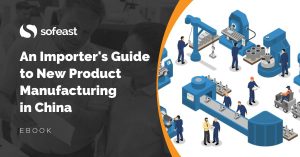If you have already done the hard work of building a look-alike and work-alike prototype, congratulations! However, there are still these 7 most common pitfalls you have to avoid while going from prototype to production…
7 pitfalls that lie in wait before you get to mass production of your electrical or mechanical product
Unfortunately, many people think having a prototype is the final step before launching mass production. And, for electronic and/or mechanical products, that’s a dangerous misconception.
Let’s examine each pitfall that can badly affect your plans to go from prototype to production smoothly here:
1. Confirming a product design that is not ready for manufacturing
Many startups hack together a product that is controlled by an Arduino module and enclosed in a 3D-printed plastic casing. And, since their designers have no/little experience with manufacturing processes, they are not aware that a deep re-design is going to be a must.
The rule is simple: as long as your design hasn’t be reviewed thoroughly by someone familiar with the manufacturing processes and the materials that will be used, you can’t assume you are “ready for production”. And that might require talking to component suppliers and, sometimes, having them work on a ‘proof of concept’ to validate their claims.
We have worked with teams of engineers who designed a “perfect product” and that had to go for a very different concept once they were told its parts couldn’t be made in large numbers at an acceptable price.
2. Going for tooling before the whole product design is frozen
At the other extreme, some people get the tooling (often plastic injection molds) made too early. Their R&D team reassures them — the rest of the design is “just getting fine-tuned”. Why not get the tooling made now, rather than later? It will take 45+ days, so why wait?
Unfortunately, in most cases where this happens, there are still changes in the design, and in some cases, the tooling has to be severely adjusted (which takes time and is not cheap) or even discarded!
You can make certain choices and speed up your product development, as we suggested in this article. And some other choices, like starting too early with tooling fabrication, are seldom wise (listen as we discuss tooling fabrication management and challenges on my podcast).
3. Running a Kickstarter or Indiegogo campaign too early
As I wrote in Pros and Cons of Crowdfunding (Kickstarter/Indiegogo) for Startups, crowdfunding is quite attractive. It raises funds when it succeeds, but also it validates market traction and it opens new doors.
It typically starts when you have a nice prototype. Here is how Indiegogo defines it:
Now, let’s say your campaign is successful. Your position becomes weaker on two fronts:
- The clock is ticking. Other companies have seen your success. Some people might decide to develop their own version of your concept at what they call “Shenzhen speed”… Quick & dirty, but usually “doing the job” and much cheaper than your offering.
- Your own manufacturer also knows your back is against the wall. You have promised a certain timing for shipping the first products. If your manufacturer knows you can’t leave them (as you’d waste a lot of time starting from scratch with another supplier), you are not in a position of strength. That’s when notices such as “the components got much more expensive, so we are revising the price up again” become very likely.
4. Doing a crowdfunding campaign and making no margin on it
Most people underestimate the costs they will incur to market, make, and ship the products.
Have you built a financial model of the way you will bring people to the Kickstarter/Indiegogo page? Will you pay Facebook ads, for example? It is often more expensive to make the maths work than people imagine.
And there will be unexpected costs cropping up in the materials & components, in the packaging, in the shipment, maybe in the custom laser engraving, etc.
Don’t sell your product at too low a price! The idea is to collect funds that will allow you to go into production.
5. Not preparing a test plan for performance or for reliability
Is the product design really validated? If you haven’t built a testing plan and you haven’t tested the prototypes accordingly, how would you know?
If the product doesn’t work long enough in the users’ hands or doesn’t deliver the performance they need, you will have to fight against bad reviews. Not fun!
It is important to slow down a bit. Document what the product does well, and quantify that if possible. Think of how users are likely to use the product, and how long it should remain in working condition. Then, plan for (reliability) life testing.
At some point in the prototype stage, it is also very good to send samples for accelerated life testing and to push them to failure. You will know the weaknesses of your design and your next iteration will be better.
6. Not forcing the manufacturer to do a pilot run before mass production
The sign of a mediocre manufacturer is their unwillingness to do pilot runs (typically on 20 to 100 pcs only) for validating that a new product can be made without serious issues.
The reason is simple. If some manufacturing or testing processes are not ready, the consequences during a mass production run can be very, very expensive.
If you have not discussed this with your assembly partner, do it now. And do not negotiate — that’s really important.
7. Failing to have the manufacturer sign a development & manufacturing contract
Do you want to have visibility over the sources of the key components?
Do you want the supplier to be accountable if there are many quality issues?
Do you want to make sure the tooling really belongs to you and you pull it at any time?
A good contract will help you make your expectations clear and will raise the odds that you get what you want. Steve Dickinson, a lawyer at Harris Bricken, wrote a nice series of articles on this topic. I also discussed product development agreements and manufacturing contracts on my podcast.
Have your say…
Have I forgotten some very common pitfalls when going from prototype to production? Please let me know in the comments!
Disclaimer
We are not lawyers. What we wrote above is based only on our understanding of legal requirements. QualityInspection.org does not present this information as a basis for you to make decisions, and we do not accept any liability if you do so.
Are you designing, or developing a new product that will be manufactured in China?
Sofeast has created An Importer’s Guide to New Product Manufacturing in China for entrepreneurs, hardware startups, and SMEs which gives you advance warning about the 3 most common pitfalls that can catch you out, and the best practices that the ‘large companies’ follow that YOU can adopt for a successful project including getting from prototype to production.
Just hit the button below to get your copy (please note, this will direct you to my company Sofeast.com):



